Essential Kite Repair Parts Every Kiteboarder Should Know
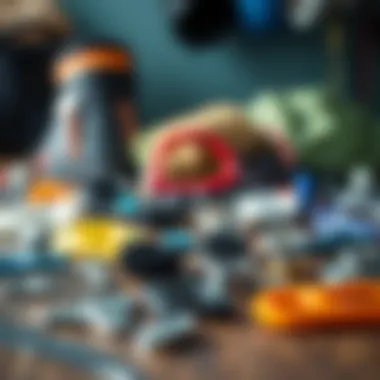
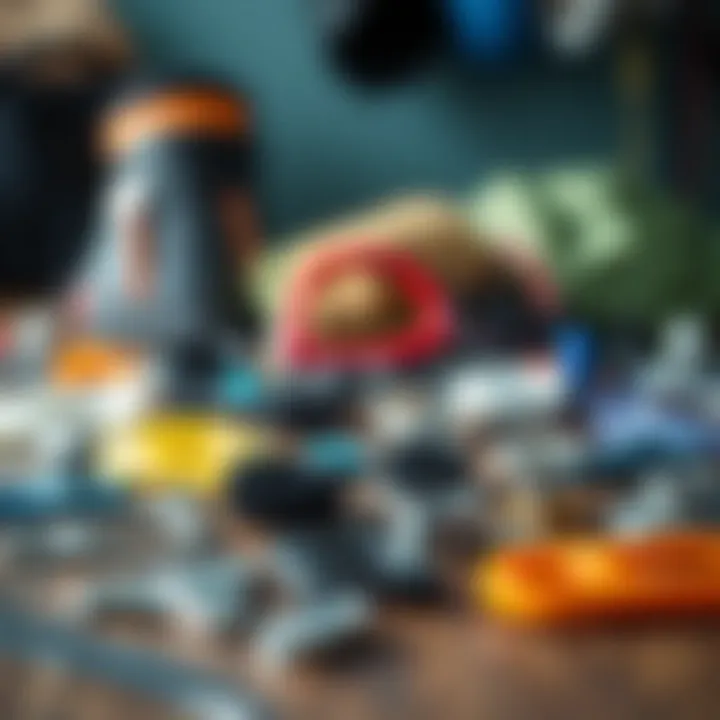
Intro
For those who enjoy the rush of kiteboarding, understanding the ins and outs of kite repair is as vital as mastering the wind and waves. Damage to kites can occur unexpectedly—whether from a rogue branch in the air, a poorly landed jump, or even just wear and tear over time. Grasping the critical elements involved in kite repairs enables enthusiasts to maintain their gear effectively, potentially saving time and money while significantly keeping their rides smooth.
This article dives into the key components tied to kite repair, covering the types of damage often encountered, the materials necessary for effective repairs, and the art of sourcing the right parts. It’s designed not just for seasoned kiteboarders but also for those still finding their footing in this exhilarating sport. By getting a grip on these topics, you’ll be well-equipped to handle issues that may arise, ensuring a longer life for your beloved kites and enhancing your overall experience on the water.
Gear Selection
Selecting the right gear is foundational to any kiteboarder’s journey. Not just in terms of choosing a kite and board but also understanding the intricacies of equipment maintenance post-selection.
Types of Kites
Kites come in various shapes and sizes, and each type serves a different purpose. When it’s time to repair, knowing which type suits your style can help inform what parts and techniques you'll need. Here’s a breakdown of common kite types:
- C-Kites: Known for their excellent performance in terms of upwind flying and speed. Repairs might focus on specific line attachments or bladder replacements.
- Bow Kites: These provide a larger wind range and are often easier to relaunch. If these types experience tears in the canopy, the repair may involve patching with specific materials to maintain performance.
- Delta Kites: A compromise between the C-kite and Bow. They focus on versatility but might come with unique repair needs, such as bridging the center strut.
Choosing a kite that aligns with your skill level and preferred riding conditions can make a significant difference, especially when repairs are needed. An ill-suited kite can lead to more wear and tear, making maintenance all the more critical.
Choosing the Right Board
Just as important as your kite selection, the board you choose impacts your kiteboarding experience. A mismatch in equipment can lead to greater difficulty in control and handling, complicating repairs later on. Here’s what to keep in mind while selecting your board:
- Size: Larger boards provide more stability and can handle rough waters, while smaller boards offer maneuverability and speed. A crack in a large board might require a different repair strategy than that on a more compact style.
- Material: The type of material affects durability; fiberglass boards may react differently to impact compared to carbon fiber ones. Understanding these materials will aid in determining the right adhesives or repair kits to use.
"Investing in the right gear not only enhances your performance but also eases the repair process when damage occurs."
By familiarizing oneself with the various types of kites and boards available, a kiteboarder will not only be skilled in choosing the right gear but also adept in understanding how to maintain and repair them. This knowledge lays the groundwork for a more enjoyable and less interrupted kiteboarding experience.
The Importance of Kite Repair Parts
Kiteboarding is not just about the thrill of riding the waves; it's also about the relationship you cultivate with your equipment. Understanding kite repair parts is critical for any kiteboarder who wishes to maintain the integrity and performance of their gear. Kite repairs are not merely an afterthought but a vital aspect of engaging in this exhilarating sport.
In the world of kiteboarding, where conditions can change in the blink of an eye, equipment reliability is paramount. Every kite is a finely-tuned instrument, constructed from various components that each play a unique role in its functionality. Therefore, being aware of the repair parts helps you better understand these components and how they work together, enhancing your confidence on the water.
Understanding Kite Structure
Kites are complex structures composed of several key elements: the canopy, the frame, and the control system. Each has its own specific function that contributes to the kite's overall performance. The canopy, often made of durable materials like ripstop nylon, is designed to catch wind and produce lift. In contrast, the frame, usually constructed from lightweight yet sturdy materials, provides the necessary support to ensure the kite holds its shape under varying wind conditions. Finally, the control system, which includes lines and harnesses, is crucial for steering and stability.
When a component fails, the entire performance of the kite can be affected. For example, a small tear in the canopy can lead to extensive damage if left unattended, and a broken frame can render the kite unusable. Thus, understanding these elements helps kiteboarders not only make informed decisions about repairs but also adopt preventative measures to keep their kite in mint condition.
Why Repairs Matter
The benefits of timely kite repairs cannot be overstated. For one, they extend the lifespan of your equipment, allowing you to enjoy more sessions on the water without having to fork out for new gear. Think of your kite as an investment; like any investment, it requires upkeep to maintain its value.
Moreover, regular repairs enhance safety. A well-maintained kite is less likely to fail in critical moments, reducing the risk of accidents that could arise from sudden equipment failure. Kiteboarding can be thrilling, but it also comes with its inherent risks.
In essence, paying attention to the condition of your kite and being prepared to handle repairs equips you with the knowledge needed to enjoy the sport more safely and responsibly. Chucking away a damaged kite is not always the best course of action. Understanding and sourcing the right repair parts can transform a seemingly useless piece of gear back into something ready for action.
Common Types of Kite Damage
Understanding the common types of kite damage is essential for kiteboarders. Recognizing the various ways your equipment can suffer harm allows for proactive maintenance, minimizing breakdowns during a session. When you know what to look for, not only can you keep your kite in top shape but also enhance your skills and enjoyment on the water. It's a matter of combining observation with preventive strategies, which in turn leads to safer and more reliable kiteboarding experiences.
Tears and Rips
Tears and rips in the fabric of your kite are among the most common types of damage. They can occur for various reasons, ranging from sharp objects like rocks or shells to the normal wear and tear that comes with usage over time. The fabric is usually made from durable materials, yet its fibers could become frayed, leading to small tears that can widen quickly if not addressed promptly.
Addressing these issues starts with a thorough inspection after each ride; this is crucial. Tiny tears can often be repaired with fabric patches if caught early enough. These patches can be an exact match or come from different fabrics, as long as they provide similar durability. Utilizing the right adhesive is equally important; otherwise, the patch might not hold, resulting in further damage.
“It's better to have a small repair now than a big one later!”
A few minutes spent identifying and repairing these flaws can mean the difference between a day of fun and an unexpected trip back to shore.
Broken Frameworks
A kite's framework, comprising its spars and other structural supports, plays a crucial role in maintaining its shape and function. Damage to this framework can significantly impact how well the kite flies. Breaks can happen due to excessive force in strong winds or mishandling during transport.
When you discover a broken framework, it’s essential to assess the extent of the damage. Some breaks can be repaired merely by replacing individual spar sections, while others may demand more comprehensive repairs. Always look for the manufacturer's specifications when sourcing replacements. It is suggested to have a backup framework or spare parts, which can help make quick repairs more feasible.
Worn Out Lines
Lines, the unsung heroes of kiteboarding, endure a lot during each session. With frequent launches, landings, and the pull of wind, these lines can become worn out or frayed. Damaged lines may not only impact the performance of your kite but can also pose safety risks.
Regularly check your lines for signs of wear, such as discoloration or thin spots. When issues are spotted, replacing the lines promptly is vital. Choosing the right type of line is crucial; some prefer thicker lines for durability, while others may opt for lighter ones that allow for better maneuverability. New lines should be installed carefully, ensuring they are threaded correctly through the kite's pulleys. Take your time to confirm that everything is in order; a faulty line can lead to unexpected failures at crucial moments.
Maintaining your kite involves understanding these common types of damage. By being proactive and knowledgeable, kiteboarders can significantly improve the longevity and safety of their equipment. With simple inspections and timely repairs, enjoyment on the water can persist, unimpeded by unforeseen interruptions.
Essential Kite Repair Parts
Kiteboarding is an exhilarating activity that requires reliable equipment, and this is where understanding the essential kite repair parts comes into play. Investing the time to learn about these components not only prolongs the life of your kite but also ensures safety during use. So, knowing what parts are crucial for repairs can save kiteboarders from unexpected interruptions on those perfect windy days.
Fabric Patches
Fabric patches act as the first line of defense against minor tears and damages that can impact kite performance.
Types of Fabrics
When it comes to types of fabrics, there’s a variety of options available, each with its own distinct qualities. Commonly used materials include ripstop nylon and polyester. Ripstop nylon is lightweight and boasts high durability; this fabric is often preferred due to its resistance to tearing and easy application. On the other hand, polyester materials provide great UV resistance, which can be a significant advantage when kites are exposed to the sun for extended periods.
Specialty fabrics, such as TPU (thermoplastic polyurethane), also come into play, offering sleek designs and remarkable flexibility. The downside to TPU, however, is its weight, which may affect wind performance.
Application Techniques
The application techniques are a crucial aspect of ensuring that fabric patches adhere properly and provide long-lasting results. Clean and prepare the area around the tear before applying the patch is important to achieve a solid hold. Typically, a heat-activated adhesive can guarantee a seamless bond, making it a popular choice. Consider using a patch that matches the kite's color and pattern—this doesn’t just ensure functionality but keeps your gear looking sharp.
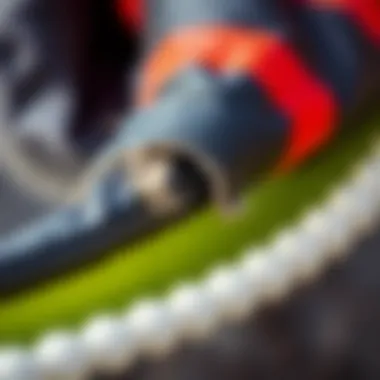
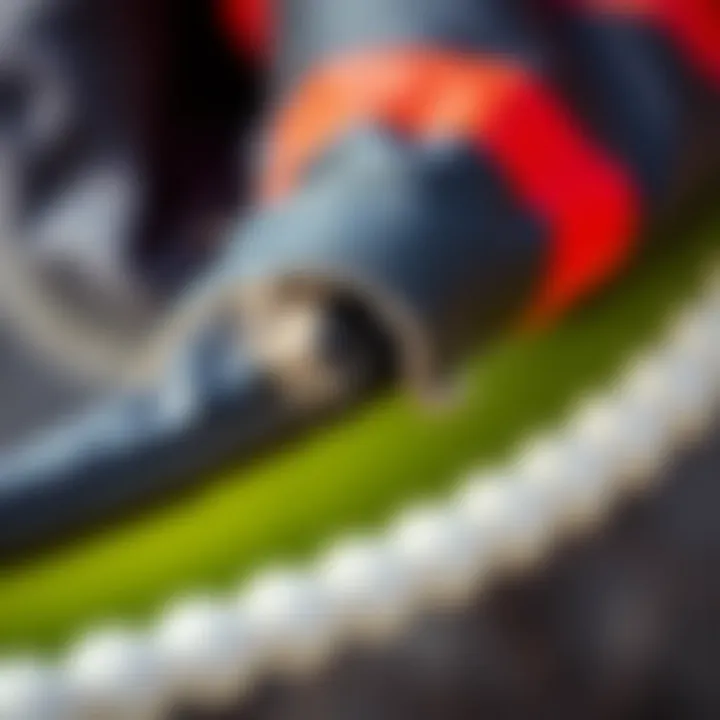
However, one must also remain cautious, as improper application can lead to bubble formation or lifting edges, which might result in new issues down the line.
Leading Edge Tubes
The leading edge tubes are the backbone of a kite’s structure, and maintaining these parts is vital for effective performance.
Material Options
When we discuss material options for leading edge tubes, it’s important to recognize that these tubes are fabricated from various materials like aluminum or PVC. Aluminum is lightweight, offering excellent durability without adding much bulk, while PVC tends to be slightly heavier but offers a longer lifespan against the elements. The right choice will depend on the kit's design, but generally, switching to lightweight materials can enhance wind responsiveness significantly.
Despite their advantages, a barrier exists; aluminum might not be as forgiving during impact, leading to dents, while PVC can become brittle in extreme temperatures.
Replacement Methods
Replacement methods for leading edge tubes must be approached methodically. First, it is critical to assess the condition of the damaged tube. Sometimes, it might be as simple as replacing a section of the tube, while others may require an entire new setup. Tools like a heat gun might be used for softening any bonding adhesives prior to replacement.
Many kits include all necessary parts and tools for replacements, but experience comes into play to ensure the right measures are taken to avoid complications down the road.
Bridle Lines
Bridle lines play an essential role in navigating a kite's flight dynamics, requiring careful selection and maintenance.
Choosing the Right Line
Choosing the right line is paramount to guarantee stability and control. Bridle lines usually utilize low-stretch, high-tenacity materials, such as Dyneema, for their durability and excellent strength-to-weight ratio. This ensures that they resist wear and provide consistent performance, crucial for handling strong winds.
The downside is that as these lines wear down, the risk of increased stretch can lead to decreased responsiveness, which can dampen the kite's overall performance.
Installation Process
Installing new bridle lines isn't just about picking them and attaching them; there's a systematic process required. Proper measurement and understanding where each line attaches on your kite can prevent mishaps. Ensure you maintain adjustments in tension so that the bridle operates effectively in both light and strong winds.
Taking the time to adjust and test the setup may seem tedious, but the eventual smoother rides will be more than worth it.
Repair Kits
Having a well-stocked repair kit at hand is necessary for any serious kiteboarder to respond quickly to damage and ensure equipment readiness.
Contents of Kits
The contents of repair kits vary, but good kits generally include fabric patches, adhesive, leading edge tube materials, and bridle lines. You can find variations with additional items like scissors and instructional materials for ease of use. Choosing a comprehensive kit means you are well-prepared for the myriad of issues that might come up on a kiteboarding outing.
On the flip side, some kits may skimp on quality materials, leading to frustration when repairs fail to stick; a good idea is always to double-check product reviews before purchasing.
Benefits of Kits
Benefits of repair kits are that they provide everything you need in one convenient package, saving time and hassle—no more running around searching for individual components when damage occurs. Additionally, having a kit readily available promotes a proactive approach to maintenance, ultimately extending the lifespan of kites.
However, it’s crucial to note that not all kits are equal in quality, and skimping on this essential investment could lead you into tricky situations out on the water.
Understanding and utilizing these essential kite repair parts elevates the performance and reliability of your gear. Kiteboarding might be thrilling, but with the right knowledge and components, it can also be incredibly secure.
Materials Used in Kite Repairs
Kite repairs are not just about patching up what's broken; they’re about maintaining the integrity and performance of your gear. The right materials can make all the difference, ensuring your kite withstands the rigors of the wind and water. In this section, we'll delve into the materials that are essential for kite repairs and why understanding them is crucial for any kiteboarder.
Types of Fabric
When it comes to kite repairs, the type of fabric you use plays a significant role in how successfully you can mend damage. Different fabrics have unique characteristics that influence their durability, weight, and resistance to UV rays.
- Ripstop Nylon: This is one of the most commonly used fabrics in kite manufacturing. It's lightweight yet strong, with a grid pattern that helps prevent tears from spreading. Ideal for patching up small rips or repairing sections of the canopy.
- Dacron: Known for its strength and resistance to stretching, Dacron is often used in the leading edges and the trailing edges of kites. It’s also a good choice for repairs due to its durability.
- Mylar: This is less common but can be found in performance kites. It’s excellent for its low weight and robustness, making it suitable for high-performance applications but may require special adhesives.
Considerations for Fabric Selection
Choosing the right fabric isn't just about finding something similar to the original material. Considerations include:
- Weight and impact on performance: Heavier fabrics may alter how a kite flies, affecting its responsiveness.
- Color match: While this may seem aesthetic, proper color matching can help in seamless repairs, especially for those who care about their kite's appearance.
- Ease of application: Some fabrics might require specialized techniques or adhesives, impacting your repair time.
Adhesives and Tapes
No repair is complete without the right adhesive or tape. Selecting an incorrect one may lead to shoddy repairs that won’t withstand the pressure of the elements.
- Sail Repair Tape: This is a specialized tape designed for fabric repairs and can often be a quick fix for tears and rips. It adheres well to most fabrics and is not affected by water, making it suitable for urgent fixes.
- Contact Adhesive: For more permanent repairs, contact adhesives work well with fabric. This type of glue requires careful application, but once set, it creates a strong bond that can handle stress.
- Duct Tape: While not ideal for long-term repairs, duct tape can serve as a temporary solution. It's versatile, easily accessible, and can be used to quickly hold things together until you can perform a proper repair.
Important Note: Regardless of the adhesive or tape you use, the surface must be clean and dry during application to ensure that the bond holds effectively.
By understanding the materials involved in kite repairs, kiteboarders can turn a daunting task into a manageable one. Using the right fabrics, adhesives, and tapes not only ensures success in mending the kite but also prolongs its lifespan, allowing for many more sessions on the water.
For more detailed information on kite maintenance and repair, resources such as Wikimedia Commons and forums like reddit.com/r/kiteboarding are invaluable.
Sourcing Kite Repair Parts
Finding the right kite repair parts can often feel like looking for a needle in a haystack. However, understanding the different avenues available to acquire these essential components is crucial for kiteboarders aiming to prolong the life of their equipment. Whether you are a seasoned pro or a weekend warrior, knowing where to look helps ensure your kite will be in peak condition when you hit the water. Here, we will discuss various options for sourcing kite repair parts, emphasizing the advantages and unique considerations of each.
Online Retailers
The internet has dramatically altered the way we shop, and kite repair parts are no exception. Online retailers provide an extensive array of components that may not be available locally. Moreover, you can compare prices and specifications easily, which saves time and often money.
Advantages of Online Shopping:
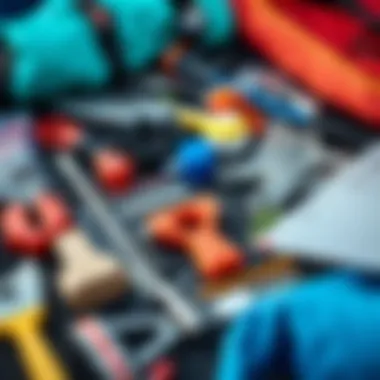
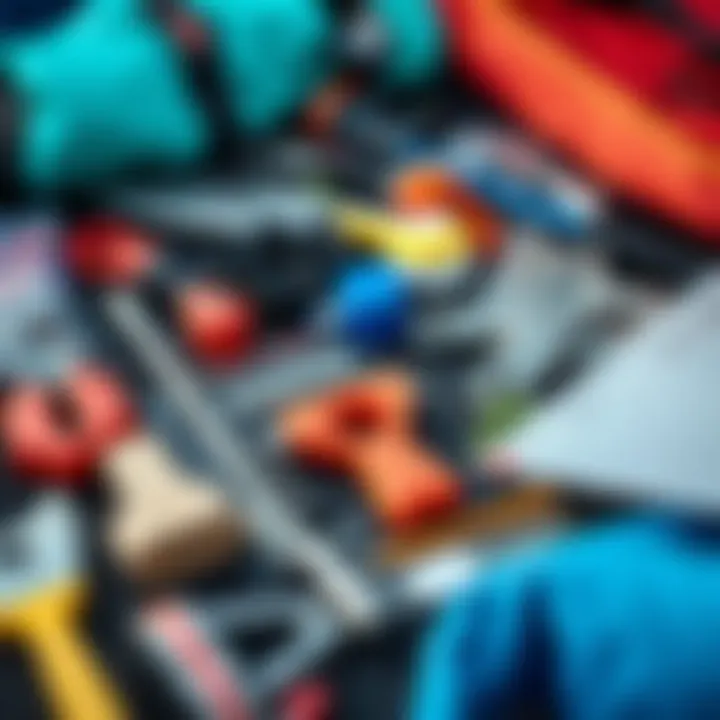
- Wide Range of Options: Websites like Amazon, Kiteboarding.com, and eBay offer numerous brands and types of repair parts.
- User Reviews: Reading feedback from fellow kiteboarders can guide you to the best choices. Users often share their experiences with specific products, which can be invaluable in deciding what to purchase.
- Convenience: You can shop at any hour, making it easy for busy individuals to find what they need, when they need it.
However, one must be cautious about third-party sellers to avoid counterfeit parts. Always check the seller's reputation and if possible, opt for established brands.
Local Shops
While online shopping has its perks, local shops offer a tangible experience you can’t replicate online. Walking into a store lets you interact with the staff, usually knowledgeable kiteboarders themselves who can provide personalized advice. Plus, you can inspect the quality of the parts firsthand.
Benefits of Local Shops:
- Immediate Availability: You can take your repairs into your own hands right away, rather than waiting for shipping.
- Personal Assistance: Knowledgeable staff can help with specific recommendations and tips for installation and maintenance.
- Support Local Businesses: Purchasing from local shops contributes to your community and can foster relationships with fellow enthusiasts.
Hitting up a local shop may cost a bit more than online options, but the immediate support can often justify the expense. Build relationships with the staff; they might offer insight into local kiteboarding events or helpful tips about care and maintenance.
DIY Solutions
If you’re feeling a bit adventurous and don’t mind getting your hands a little dirty, DIY solutions can be a great way to source kite repair parts. Many kiteboarders cultivate a do-it-yourself spirit by creating or modifying parts themselves. This path can be both economical and rewarding.
Ideas for DIY Sourcing:
- Upcycling Materials: Utilize old kites or gear you no longer use. You can salvage fabric, lines, and even hardware.
- Local Workshops: Attending community workshops can connect you with experts who can share their craft and tools, be it mending fabric or replacing lines.
- Customization: You can tailor your repairs to meet your specific needs or preferences, ensuring your kite feels just right.
The DIY path does come with its challenges as it requires basic skills and tools, but the gratification of completing a repair on your own can be very fulfilling. Engagement in the kiteboarding community can be a great motivator, too.
"A kiteboarder's toolkit is only as strong as their resourcefulness; explore every nook and cranny for repair solutions!"
In summary, sourcing kite repair parts involves understanding both the vast landscape of online retailers and the advantages of local shops, along with the intriguing potential of DIY solutions. By weighing these options, kiteboarders can ensure they have access to the necessary components to keep their gear in fighting shape.
For more information, check resources like Reddit or local community boards.
Performing Common Repairs
Kiteboarding is a thrilling sport that requires not just skill but also the right equipment. Over time, kites can sustain various types of damage requiring that some common repairs are performed to maintain optimal performance. Knowing how to conduct these repairs can drastically reduce your downtime on the water. In this section, we will discuss three common repairs: fixing torn fabric, replacing leading edge tubes, and conducting line replacements. Each repair process comes with its own set of tools and instructions, ensuring you can handle these situations as they arise.
Repairing Torn Fabric
Tears in the fabric of a kite can lead to significant performance issues. A well-repaired tear helps restore the kite's structural integrity, allowing you to fly for longer without enterprise concerns.
Step-by-Step Guide
When it comes to repairing torn fabric, having a step-by-step guide can be invaluable. There’s a logical sequence you can follow:
- Clean the area: Remove any debris, sand, or dirt around the tear.
- Cut Fabric Patches: Choose a patching fabric that matches the kite’s material.
- Apply Adhesive: Use a strong adhesive specifically meant for fabric repairs.
- Press and Hold: Ensure the patch adheres properly, pressing firmly and holding for the recommended time.
- Test the Repair: Finally, test the repair on the ground before hitting the water.
This guide is beneficial because it provides clear instructions that step you through the repair process, reducing the chance of errors. One unique feature is that it emphasizes using matching fabric, which contributes to a more aesthetically pleasing and functional result. However, if a patch is poorly adhered or improperly placed, it can lead to further issues when the kite is under stress.
Important Considerations
There are key points to consider when repairing torn fabric. Firstly, the type of adhesive you use is crucial for ensuring durability. Not all glues are created equal; some are water-soluble and may fail when exposed to elements during kiteboarding.
Another important characteristic is the size of the patch. It should extend beyond the torn area to ensure robust repair strength. If the patch is too small, the tear may re-open quickly under pressure. A well-thought-out repair can not only save equipment costs but can also enhance your confidence when flying your kite once more.
Replacing Leading Edge Tubes
The leading edge of a kite plays a critical role in its shape and performance. When tubes become bent or broken, replacing them is essential to ensure that the kite maintains its structure.
Tools Needed
To replace leading edge tubes, you will need several tools:
- Tube Cutter: A clean, angled cut is essential for perfect fitting.
- Measuring Tape: For precision in sizing your new tubes.
- Adhesive: Depending on the tube type, you may need a special kind of glue that’s waterproof.
Having the right tools makes this process much smoother and cuts down on mistakes. The tube cutter, for instance, offers a clean cut, allowing for fitting that won’t snag or misalign later on. Still, if you lack precision in measurements, even the best tools won’t save you when new tubes don’t fit correctly.
Replacement Instructions
The replacement of leading edge tubes typically follows these instructions:
- Measure the Damaged Tube: Depending on damage size, cut the new tube accordingly.
- Remove the Old Tube: Carefully detach it from the kite without damaging the fabric.
- Insert the New Tube: Gently slide it into place and check for any misalignment.
- Seal the Connection: Use adhesive to secure the tube, ensuring a tight fit.
These instructions are popular because they cover essential steps without overwhelming the reader. Rigorously following them can prevent the risk of making the whole kite unusable. The main disadvantage is that not all kites have the same tube specifications, which requires knowledge of your specific model.
Conducting Line Replacements
Worn-out lines can significantly diminish your kiteboarding experience. Replacing them is necessary for safety and performance.
Assessment of Lines
Before diving into replacements, a thorough assessment of existing lines is vital.
- Look for fraying or signs of wear, especially at connection points.
- Check for kinks or twists which can affect performance.
Assessments are crucial as they help determine whether a line can be repaired or needs outright replacement. The advantage here is that regular checks can identify minor issues before they develop into substantial problems; however, overlooking this crucial step can lead to unexpected kite failures while riding.
Replacement Process
Once assessment is complete, here’s how to conduct the line replacements:
- Detach the Old Line: Carefully unclip the old line from the bridle and take note of its alignment.
- Measure New Line: Cut a new line with the same specifications.
- Attach New Line: Clip it in the same alignment as the old one to prevent mishaps while flying.
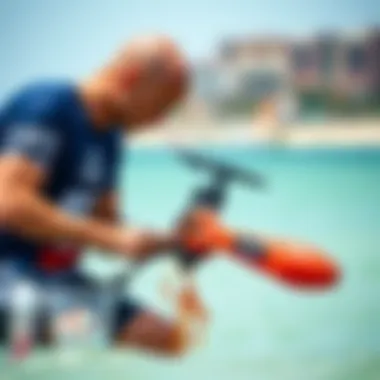
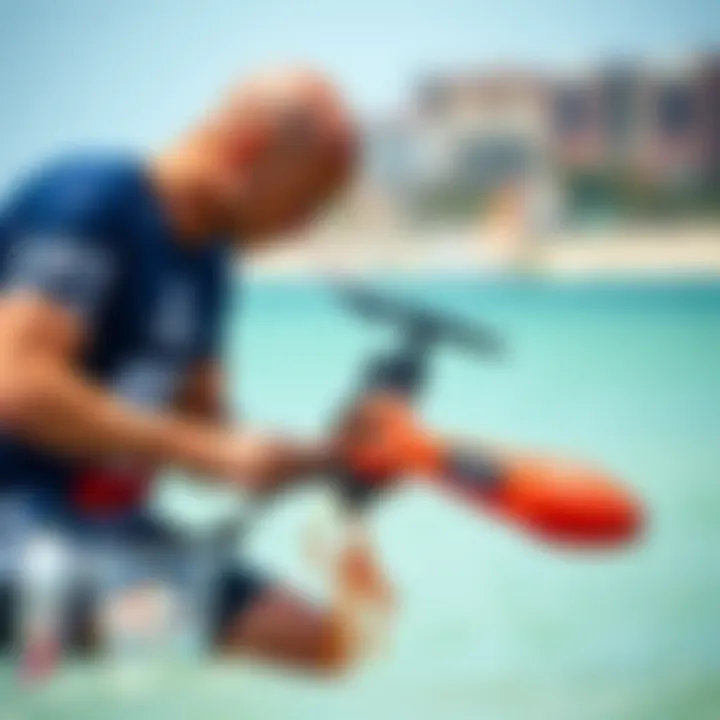
This process is stringent yet straightforward, making it an appealing option for DIY repairs. The uniqueness lies in aligning everything just right; incorrect setup can lead to disastrous outcomes.
In summary, understanding how to perform these common repairs can help kiteboarders maintain their gear more effectively, maximizing enjoyment on the water. Smooth sailing—or flying—often hinges on how well these repairs are executed.
Preventive Measures for Kite Maintenance
When it comes to kiteboarding, the joy of gliding over the water can quickly be marred by unexpected equipment failures. That’s where preventive measures come into play, significantly reducing the likelihood of damage and the need for repairs. Understanding how to maintain your kite properly serves not just to prolong its life, but also enhances your overall experience on the water.
Regular Inspections
One of the most crucial aspects of kite maintenance lies in conducting regular inspections. Frequent checks can help catch issues before they escalate. Ideally, you should inspect your kite before and after each session, looking for signs of wear or damage. Here are a few key areas to focus on during inspections:
- Leading Edges: Check for fraying or punctures. These are often the first points to encounter damage due to their direct contact with the wind.
- Bridle System: Inspect the bridle lines for tangles, excessive stretching, or signs of wear.
- Canopy and Trailing Edge: Examine these areas for tears or punctures. Small rips can grow significantly if left unaddressed.
- Connections and Pulleys: Look for wear on the connectors and pulleys, as these components bear the brunt of mechanical stress and can fail unexpectedly.
By making inspections a habit, you're not just waiting for problems to arise but actively preventing them. This proactive approach can keep your kite in top shape and let you enjoy countless rides without unexpected interruptions.
Proper Storage Techniques
Just as important as inspections, the way you store your kite can dramatically affect its longevity. Keeping it safe from moisture, direct sunlight, and extreme temperatures is vital. Here are some best practices for proper storage:
- Dry Before Storing: Always ensure that your kite is completely dry before packing it away. This prevents mold growth and material degradation.
- Use a Bag or Case: Store your kite in a protective bag to shield it from environmental hazards like dust, dirt, or critters that might chew on the lines.
- Avoid Sharp Objects: When storing, ensure that the kite is away from sharp edges or items that could puncture it.
- Controlled Environment: If possible, store kites in a cool, dry place rather than a hot attic or damp basement.
By being mindful about how you store your gear, you safeguard your investment and maintain the integrity of your equipment for those thrilling sessions ahead. Remember, just like keeping your body in shape contributes to your performance, taking care of your kite ensures that you’re always ready to hit the waves or the wind.
“An ounce of prevention is worth a pound of cure.” — Benjamin Franklin
These preventive measures can save you from costly repairs and potentially hazardous situations out in the water. For more insights and discussions, joining kiteboarding communities on platforms like Reddit, or even exploring local shops can offer invaluable support and knowledge.
Safety Considerations in Kite Repair
When diving into kite repairs, safety should be the highest priority. Engaging in activities that involve kites—whether it be setting up, mending, or performing routine checks—carries inherent risks. Understanding these risks, as well as adopting safety measures, not only protects the kiteboarder but also extends the lifespan of the equipment. This part serves as a crucial reminder that kite maintenance goes beyond just technical know-how; it intertwines with a sensible approach towards safety.
Understanding Risks
Many kiteboarders may not fully grasp the risks involved in repairs. From sharp materials to the unexpected failure of components, these issues can cause serious injuries if proper precautions are not taken. Below are some noteworthy risks:
- Sharp Tools: Scissors, utility knives, and other repair tools can lead to cuts or accidents if not handled carefully.
- Pressure and Tension: A kite’s lines are often under tension, and improper handling can cause them to snap back, leading to potential injury.
- Electric Elements: Some advanced kites may contain electronic components, which could pose electrical hazards during repairs.
- Compromised Materials: Over time, wear and tear can weaken the fabric or structural integrity of the kite, making repairs a risky endeavor without adequate knowledge.
Recognizing these risks can help kiteboarders gear up mentally and physically for the tasks ahead, thus avoiding injuries that could sideline their beloved sport.
Best Practices
To ensure that kite repairs are completed safely, there are several best practices to follow:
- Wear Safety Gear: Always use gloves and eyewear when working with sharp tools or handling materials that could cause injuries. This simple step can prevent small accidents from turning into big problems.
- Work in a Controlled Environment: Set up your repair area in a clear, clutter-free space where distractions are minimized. This leads to better focus and fewer chances of accidents.
- Use Quality Materials: Ensure that any replacement parts or repair materials are of high quality. Poorly made components can lead to further issues down the line, possibly resulting in accidents.
- Follow Instructions: Engage with detailed guides or instructional videos for repairs. Resources like YouTube or instructional forums on platforms like Reddit can be invaluable for understanding the safest repair techniques.
- Seek Advice: Reach out to experienced kiteboarders or join local workshops for hands-on guidance. Learning from others can help mitigate risks when tackling repairs.
Adhering to these best practices creates an environment where repairs can be carried out with confidence and effectiveness, ensuring both safety and quality remain at the forefront of the experience.
Connecting with the Kiteboarding Community
Engaging with the kiteboarding community is not just a nice-to-have; it’s essential for any kiteboarder looking to elevate their skills and knowledge, especially in areas like kite repair. The wealth of information shared within these circles can be a game changer, transforming what could be a frustrating experience into something manageable and educational. With kite repair parts and techniques constantly evolving, staying connected with fellow enthusiasts can help you adapt more swiftly to changes and challenges in your equipment.
Why connect? There’s a saying that no man is an island, and that rings true for kiteboarding. Whether you're a seasoned professional or a passionate beginner, connecting with others can offer immense value. Group discussions often reveal tips and tricks that you might not find in instructional guides or manual. Real-life experiences from other kiteboarders can provide insights into common issues and repairs. You may discover lesser-known adhesives or specific patches that perform wonders on a damaged kite. Additionally, the community often shares the latest gear reviews and recommendations, which can aid your purchasing decisions.
Forums and Groups
Forums and online groups serve as virtual gathering spots for kiteboarders all over the world. Websites like Reddit have specific threads dedicated to kiteboarding where participants freely exchange knowledge, post queries, and share fixes on repair parts. In these discussions, you'll stumble upon both the novices asking for guidance and the veterans sharing their hard-earned wisdom.
One of the most crucial advantages of these platforms is the comfort level they offer. You can ask questions without feeling embarrassed or judged for not knowing something that might seem obvious. It’s a chance to learn from a diverse set of experiences and expand your own knowledge base. Here, you might pick up advice on preparing for certain weather conditions or dealing with unforeseen damages during a session.
Additionally, interacting in these forums allows participants to create a network. You never know, you might meet someone local who's got spare parts or a workshop handy—connections that can lead to quick fixes when time is of the essence.
Repair Workshops
Repair workshops are a haven for both new and seasoned kiteboarders who wish to dive deeper into the art of kite repair. These events allow participants to engage with hands-on learning in a supportive environment. Unlike online forums, where discussions can sometimes be abstract, workshops provide practical experiences that solidify what you’ve learned.
Attending workshops often leads to direct instruction from experts in kite repairs. Understanding the specifics of different repair parts, like the best way to replace bridle lines or apply fabric patches, becomes much easier when you can see the techniques in action. Not to mention, you can ask clarifying questions right there on the spot. These sessions can vary from day-long events hosted by local shops to multi-day workshops run by travelling instructors.
Through these workshops, you not only enhance your repair skills but also meet other kiteboarders passionate about the sport. These social interactions can lead to finding new kite spots or planning collective trips—knowledge that often comes in handy later on.
In summary, connecting within the kiteboarding community, whether through forums, workshops, or informal meetups, enriches your understanding of kite repairs and transitively enhances your overall kiteboarding experience. The collective wisdom of others, along with hands-on opportunities, ensures that you have the means to keep your gear in top condition and at the ready for the next adventure.
Culmination: The Value of Understanding Kite Repair Parts
In the world of kiteboarding, understanding the repair parts isn't just a matter of maintenance; it's a cornerstone for sustaining one’s passion for the sport. Knowing how to identify, source, and replace essential kite components can mean the difference between a thrilling day on the water and a frustrating experience marred by broken gear. Kite repair parts help ensure longevity and performance, which ultimately translates into the enjoyment and safety of each ride.
When a kite experiences damage, whether it be a simple tear or a more complex framework issue, having a grasp of the repair parts needed allows the kiteboarder to tackle these problems head-on. Investing time in learning about fabric patches, bridle lines, and leading edge tubes pays off significantly. Boarders can fix issues swiftly, avoiding lengthy downtime while waiting for professional repairs. Moreover, this knowledge also fosters a sense of independence and confidence for enthusiasts. An empowered kiteboarder can carry out repairs when necessary and can instruct others in mechanics of kite repair.
Equipped with the essential knowledge, kiteboarders can make informed decisions, not just when repairing, but also in preventive maintenance. Regular inspections and proper care mitigate risks of failure on the water, ensuring each kite remains in its prime condition.
"If you think adventure is dangerous, try routine; it’s lethal." – Paulo Coelho
This sentiment holds in kiteboarding as well. Complacency can lead to unexpected mishaps. Therefore, forging a strong understanding of kite parts and repairs ensures that adventures remain just that – adventurous without the shadow of mishaps looming over them.
Also, not forgeting community engagement, connecting with other kiteboarding enthusiasts can enhance knowledge-sharing and further deepen one’s understanding of repair techniques. Simply participating in forums or attending workshops can broaden a kiteboarder's perspective on effective maintenance practices and innovative repair methods. All in all, the value of understanding kite repair parts fosters greater enjoyment, safety, and continuity in the sport, making it an essential pursuit for any dedicated kiteboarder.
Summarizing Key Takeaways
- Knowledge is Power: Comprehending the components of kite repair empowers kiteboarders to handle potential issues efficiently.
- Longevity Matters: Regular maintenance and timely repairs extend the life of your kite and optimize performance.
- Independence and Confidence: Gaining skills in repair not only builds confidence but also enriches the kiteboarding experience.
- Community Connections: Engaging with fellow enthusiasts enhances learning and provides support networks for repair questions.
Future Learning Opportunities
Exploring advanced repair techniques can further elevate one’s expertise. Here are some ideas for continued learning:
- Workshops and Clinics: Look out for kite repair workshops hosted by local shops or kiteboarding schools that can provide hands-on experience.
- Online Resources: Websites like Wikipedia (wikipedia.org) and forums like Reddit (reddit.com) can be invaluable sources of information.
- Books and Guides: Consider investing in instructional books geared towards kite repairs and maintenance. Some resources provide comprehensive guides and troubleshooting methods.
- Manufacturer Workshops: Many kite brands host repair clinics focused on their products, allowing for specialized insights and techniques.
By delving deeper into kite repair knowledge, kiteboarders can not just fix their gear but transform their entire experience on the water, leading to prolonged enjoyment and thrilling escapades in kiteboarding.















